Featured Artists
Fabric artist Kris Gregson Moss
Welcome to our newest member, Kris Gregson Moss
Kris Gregson Moss is not a quilter. She is an artist who sews pieces of fabric together in interesting shapes, this is true. But she often takes the process a step further by making them into cloth sculptures using wood and frames. It all started in her childhood. While her brothers were allowed to use hammers and nails, Kris had to wash the dishes, and, of course, sew. To make matters worse, she wasn’t allowed to take art classes in high school since she was on a college entrance track. “It was the 1960s,” she laughs.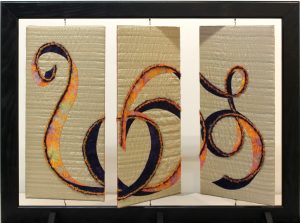
But when she got to a point in her life when she could explore the kind of art she wanted to pursue, she fought back. “I wanted to make fabric stand up,” she says. Since then, she has been making what she describes as “contrary” work, always trying new things, pushing her work beyond traditional art forms, uncomfortable following the rules.
“I pick up fabric all over. I love to use Dupioni silk. I won’t use just cotton, as is used in traditional quilts,” she says. “I am bored with rectangles so I use triangles. They have more movement. Maybe I refuse to be in a box.” When making her work, she asks “What if?” and “Can I do this?” She feels her process of creating is like playing. And her husband gets to play, too. She takes advantage of his woodworking skills for help with frames and other structural elements for her work. Kris likes abstract work because when she began making her fabric sculptures, she didn’t feel she was good enough to make representative work. Even though she has made work such as flowers and even a sea otter that hangs in her house, she still prefers the abstract.
Meanwhile, in her new home in Granville, she is creating smaller cloth objects and has been quite happy making sculptural necklaces, which have been selling well. Some of these mini sculptures look like a little lily, hanging in a trumpet shape. She calls them “Backwards at the Dinner Table” because she was wearing one and looked down to find it dangling in her coffee. (They are not washable.) She recommends flipping them around and wearing them down your back when you are eating dinner!
Many of Kris’ works have appeared in juried shows and private collections, and she just won first placein in the 3-dimensional category of the Central Adirondack Art Show at the View Gallery in Old Forge, NY, for a piece pictured here called “Synchronicity”
It will be exciting to see what comes next for Kris, especially from the inspiration she draws from the view from her new house. “I can see the length of the Green Mountains and the hills and farms of Washington County,” she says. True inspiration for an artist who doesn’t fit into a box.
Stained glass artist Diana Schleicher
Diana Schleicher often starts a stained glass project — such as a sun catcher or mosaic piece — by allowing the glass itself to suggest a subject. Sometimes it’s a landscape, a bird or insect or some kind of geometric design.
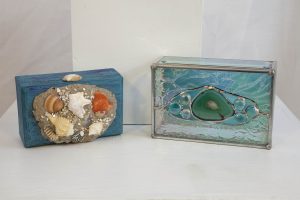 “The texture of the glass and the way the light filters through is what first sparks my interest,” she says. “I particularly like incorporating shells, beads and natural materials in the design.”
“The texture of the glass and the way the light filters through is what first sparks my interest,” she says. “I particularly like incorporating shells, beads and natural materials in the design.”
Her interest in stained glass began when she took a BOCES class more than 20 years ago when she found a local stained glass instructor. Working alongside three other students, she began going weekly to improve her skills.
But long before that first class, she was interested in art, even as a child. She studied Advertising Art and Design at the State University Agricultural and Technical Institute in Farmingdale, Long Island. Although Advertising Art wasn’t for her, she enjoyed calligraphy and later used it to create signs and posters in the various places she was employed.
As an Occupational Therapy Assistant at Pilgrim State Hospital on Long Island, her interest in art developed into a desire to try various crafts.
“I worked in several Occupational Therapy ‘shops’ with psychiatric patients in the areas of weaving, ceramics, woodworking and embroidery. I was learning as much from the patients I worked with as well as other staff,” she says. Hoping to continue working in the human service field when she moved upstate in 1977, she got a job at Community, Work and Independence and has been there 35 years.
“I was one of the original members when VAM first began. I made soft-sculptured character dolls at the time, more as a hobby. It was a new experience for me, to be around other successful artists. I later moved on to decorating boxes with birch bark and twigs from the woods behind my house. I loved using materials in nature to create usable items.”
Diana’s biggest challenge with stained glass is having the time and space to make it. Also, stained glass is unforgiving. “Unfortunately, if you make a mistake in stained glass, you either have to take it apart, or replace broken pieces. Each step is challenging, cutting glass the wrong way results in pieces of glass in shapes you can’t use. Soldering those pieces together, so your finished piece looks neat, is also challenging. This can be costly and time consuming. Having a full time job and limited work space at my house — the kitchen table — doesn’t allow me to produce as much as I’d like to,” she says. “In the future, I hope to improve my skills, and learn new techniques with glass, such as jewelry making, etching, and the use of a kiln.”
Painter Barry Targan (aka Richard Dubin)
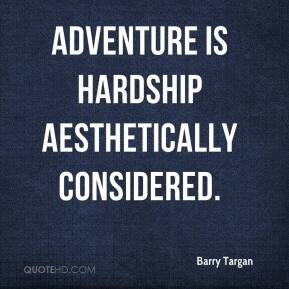
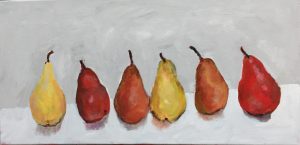 An artist is “a person who produces works in any of the arts that are primarily subject to aesthetic criteria.” If this definition is true, then I am not sure what Barry Targan is. He produces work in MANY of the arts, not just ANY. If you have seen Barry’s work at VAM (under his alias, Richard Dubin), you have enjoyed his acrylic paintings. He loves acrylic because it’s a forgiving medium. “It dries so quickly that you can almost immediately make corrections, which for me, is a great advantage,” he says.He paints from photographs, but only photographs he’s taken himself, then he enhances the images on a computer. “My method is an ancient one; that is, I grid the printed photograph and then translate that by a grid of the larger canvas,” he says. “It seems that my favorite subject is flowers, but I try to avoid just describing them. I make sometimes extreme distortions, hopefully making the painting look like flowers but also something else. I try to set the viewer’s imagination free.” One of his main subjects is still life, particularly fruits and vegetables.
An artist is “a person who produces works in any of the arts that are primarily subject to aesthetic criteria.” If this definition is true, then I am not sure what Barry Targan is. He produces work in MANY of the arts, not just ANY. If you have seen Barry’s work at VAM (under his alias, Richard Dubin), you have enjoyed his acrylic paintings. He loves acrylic because it’s a forgiving medium. “It dries so quickly that you can almost immediately make corrections, which for me, is a great advantage,” he says.He paints from photographs, but only photographs he’s taken himself, then he enhances the images on a computer. “My method is an ancient one; that is, I grid the printed photograph and then translate that by a grid of the larger canvas,” he says. “It seems that my favorite subject is flowers, but I try to avoid just describing them. I make sometimes extreme distortions, hopefully making the painting look like flowers but also something else. I try to set the viewer’s imagination free.” One of his main subjects is still life, particularly fruits and vegetables.
If you have come into VAM during one of Barry’s shifts, you may have seen him working behind his portable sewing machine. He often passes the time making quilts at VAM. But of course, he has dabbled in many art forms.
“I’ve always been interested in craft. What excites me mostly is the attempt to give an informing shape to stuff. Over the years I’ve worked in ceramics, bookbinding, weaving, quilting, wood working, boat building, polymer clay, copper enameling. My aim is to explore a medium and try and find different and unusual possibilities for it.”
Barry’s art also includes writing. He is an accomplished writer and teacher with a Ph.D. from Brandeis University. “For 42 years of my adult life, I taught 16th and 17th century English literature. For the last 20 years I taught creative writing at Binghamton University. I’ve published three collections of short stories and three novels as well as dozens more stories, essays, poems. I’ve received two Endowment of the Arts grants and a Rockefeller Foundation grant to study in Italy.”
Aside from his writing, his most ambitious and challenging work was with ceramics. “Once I had a complete ceramics studio, including two kilns that I built myself. Eventually I focused on raku. But firing a raku kiln is very hard work, and so, at my age (84), I had to give it up.”
But back to painting. Barry’s greatest influence is his wife, painter Arleen Targan, a fine and highly-respected artist (and also the reason he has an alias so that the two painters are not confused). Over the years she encouraged and mentored him. She was an early member of VAM, and in time Barry joined her.
We hope there will be much more exploration produced by Barry. “I don’t mind parting with any of my work because I’m always going on to new things,” he says. “Also, I get a kick out of thinking that someone wants something I’ve made.”
An artist is “a person who produces works in any of the arts that are subject to aesthetic criteria.” If that is true, then I am not sure what Barry Targan is. He produces work in MANY of the arts, not just ANY. If you have seen Barry’s work at VAM (under his alias, Richard Dubin), you have enjoyed his acrylic paintings. He loves acrylic because it’s a forgiving medium. “It dries so quickly that you can almost immediately make corrections, which for me, is a great advantage,” he says.
He paints from photographs, but only photographs he’s taken himself, then he enhances the images on a computer. “My method is an ancient one; that is, I grid the printed photograph and then translate that by a grid of the larger canvas,” he says. “It seems that my favorite subject is flowers, but I try to avoid only describing them. I make extreme distortions, hopefully making the painting look like flowers but also something else. I try to set the viewer’s imagination free.” One of his main subjects is still life, particularly fruits and vegetables.
If you have come into VAM during one of Barry’s shifts, you may have seen him working at his portable sewing machine. He often passes the time making quilts at VAM. But of course, he has dabbled in many art forms.
“I’ve always been interested in craft. What excites me is the attempt to give an informing shape to stuff,” he says. “Over the years, I’ve worked in ceramics, bookbinding, weaving, quilting, wood working, boat building, polymer clay and copper enameling. My aim is to explore a medium and try and find different and unusual possibilities for it.”
Barry’s art also includes writing. He is an accomplished writer and teacher with a Ph.D. from Brandeis University. “For 42 years of my adult life, I taught 16th and 17th century English literature. For the last 20 years I taught creative writing at Binghamton University. I’ve published three collections of short stories and three novels as well as dozens more stories, essays, poems. I’ve received two Endowment of the Arts grants and a Rockefeller Foundation grant to study in Italy.”
Aside from his writing, his most ambitious and challenging work was with ceramics. “Once I had a complete ceramics studio, including two kilns that I built myself. Eventually I focused on raku. But firing a raku kiln is very hard work, and so, at my age (84), I had to give it up.”
But back to painting. Barry’s greatest influence is his wife, painter Arleen Targan, a fine and highly-respected artist (and also the reason he has an alias; he does not wish the two painters to be confused). Over the years she encouraged and mentored him. She was an early member of VAM, and in time Barry joined her.
We hope there will be much more exploration produced by Barry. “I don’t mind parting with any of my work because I’m always going on to new things,” he says. “Also, I get a kick out of thinking that someone wants something I’ve made.”
Basket-maker Bliss McIntosh
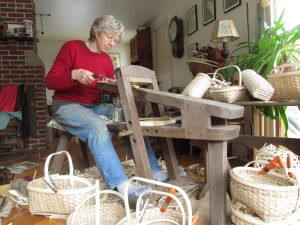 My basket-making career has roots that begin way back with learning to knit and sew when I was about 5 years old. I took over from my mother in making my own clothes and then progressed to spinning, weaving and using natural dyes when I was just finishing college. After college, I built a small cabin on land that my parents gave to me and honed my woodworking skills. By the time my husband and I married in 1977 the time was right for basket making. A dear friend gave us a basket made by Mary Tilley of Ashfield, MA and soon after that I spent a week with Mary learning the craft. It was exactly the right thing for me, incorporating my love of plants and wood, fiber, weaving and carving, with much of it done outdoors.
My basket-making career has roots that begin way back with learning to knit and sew when I was about 5 years old. I took over from my mother in making my own clothes and then progressed to spinning, weaving and using natural dyes when I was just finishing college. After college, I built a small cabin on land that my parents gave to me and honed my woodworking skills. By the time my husband and I married in 1977 the time was right for basket making. A dear friend gave us a basket made by Mary Tilley of Ashfield, MA and soon after that I spent a week with Mary learning the craft. It was exactly the right thing for me, incorporating my love of plants and wood, fiber, weaving and carving, with much of it done outdoors.
Black Ash basketmaking is a traditional American craft. The ash is obtained by cutting a Black Ash tree, removing the bark, and then pounding on the log to separate the annual rings. The splints are soaked and smoothed, then cut to dimension before weaving the baskets. I create handles and rims by splitting out white ash while it is still green or after it has been soaked and then carving it with a drawknife on a shave horse. There is nothing but wood in a finished basket and it is a strong, light, and flexible object with infinite uses. The “art” of basket making is when you decide on proportion, surface texture, the carving of the handles and the fineness of the weave. It has never lost its charm for me.
In 1990 I was introduced to a birch bark basket maker in NH and spent another week learning her techniques. Since then I have made a mixture of splint and bark baskets. Since 1977 I have also taught many workshops, usually at my home, to people who want to learn the “real” way to make a basket. I have also taught thousands of 4th graders to make reed baskets as part of their study of Native Americans and Colonial life.
I have made baskets for almost 40 years. It has been mostly a winter activity as I am a professional gardener during the summer months. I concentrate on corn husk dolls just before the holidays, then spend January and part of February weaving up a basket a day. In the late winter, I work on rims and handles and binding up. (An intern at the Crandall Library produced a 6-minute video of me making an ash splint basket.)
I am one of the founding members of Valley Artisans Market and am grateful to the market for being a simple way to display and sell my work, as well as providing me with a community of artists for friends and inspiration.
Read more about Bliss in her bio.
Photographer Ian Creitz
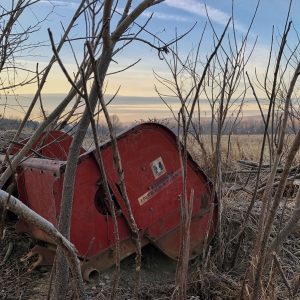
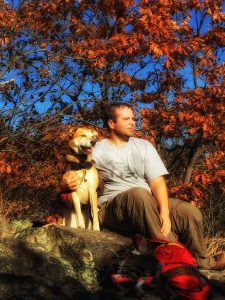 Photographer Ian Creitz has been playing with photography since he was in high school but his interest increased in 2004 when he was given his first digital camera. “From there I continued to grow in my craft. Ever few years I upgrade my equipment and continue teaching myself and picking up tips from other seasoned photographers,” he says.
Photographer Ian Creitz has been playing with photography since he was in high school but his interest increased in 2004 when he was given his first digital camera. “From there I continued to grow in my craft. Ever few years I upgrade my equipment and continue teaching myself and picking up tips from other seasoned photographers,” he says.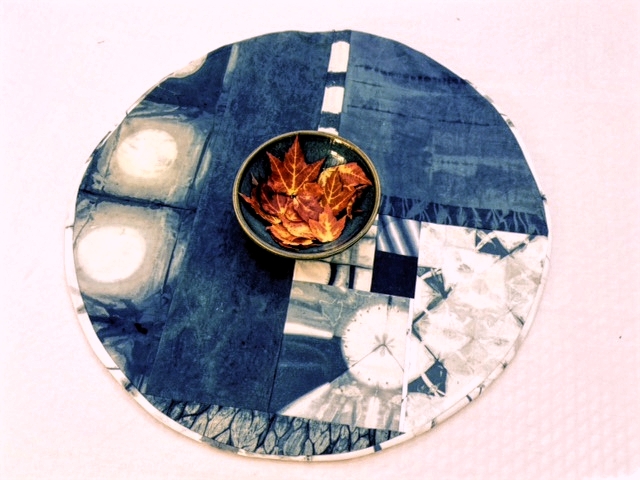
Cloth artist Luann Gilligan
Welcome to our newest member, Luann Gilligan of Round Lake, New York, who joined Valley Artisans Market in December of 2016.
Luann has been fascinated and intrigued by fabric all of her life. She has been sewing since she was 12 years old and has enjoyed all kinds of handwork: embroidery, quilting, silkscreen and surface design using paints and dyes. She went to school for clothing and textile design then went on to have an interesting path working as a sample maker for Carter’s Childrenswear, doing theater costuming work and partnering in a small company that designed and produced figure skating apparel. She has also worked doing bridal alterations.
Decades of loving fabric has led to a wonderful collection of cloth. “I’ve collected a lot, mostly in the category of bits and pieces,” she says. She stumbled upon Shibori while trying to figure out a way to make something with all those bits and pieces.
“My current work is dying natural fiber cloth with natural indigo plant dye. I use a technique called Shibori, which involves folding, clamping, stitching, twisting the fabric, then dipping it repeatedly in the dye vat. Everything is then washed, cut and sewn together,” she says.
Shibori is like tie-dye. The way Luann folds or twists the fabric will result in different patterns and designs with some areas of the cloth remaining white from being tightly wound up.
Luann currently has table runners and table toppers for sale at VAM and is interested in new twists on traditional methods for her work. “I’m interested in more experimentation with the circle theme and in moving away from the very traditional examples of shibori to develop more abstract pieces for the wall or for art quilts,” she says. “I’m also quite infatuated at the moment with sacred geometry and the Fibonacci number series for design layout.”
When she isn’t immersed in the joys of fabric, Luann is busy with many fascinating jobs, including working with an autistic child, cooking for an alternative food store, as well as finishing an apprenticeship to become a Reiki Master. She is certified to teach yoga and meditation and is developing a Conscious Breathing course for people who are stressed and overwhelmed. “Everyday is different, and I squeeze the art work in where I can,” she says.
For more information about Luann, check her bio.
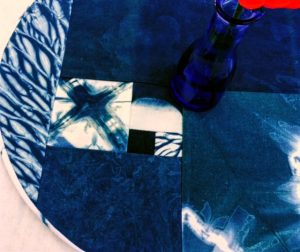
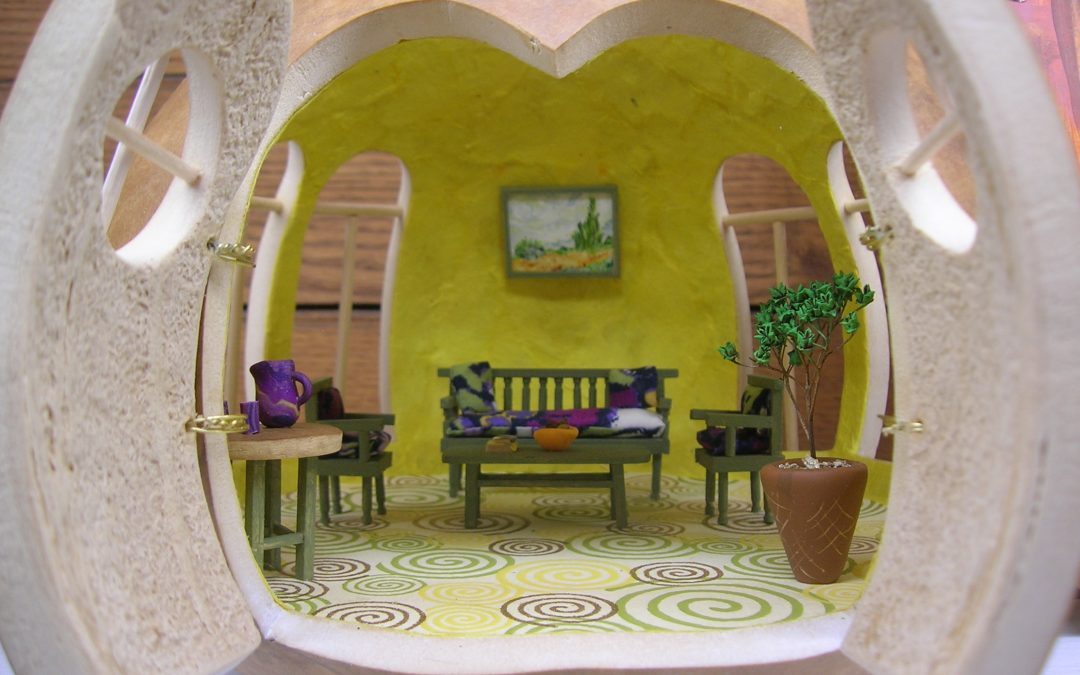
Gourd artist Chung-Ah Park
If you have walked into Valley Artisans Market, you have probably been immediately attracted to the gourd houses made by artist Chung-Ah Park. A dried gourd is cut open, given windows and doors and made into a sweet room, decorated like a dollhouse with wallpaper, rugs, tables, beds, desks and the like. The rooms have beautiful details, some very sparse and some with a variety of her carefully handmade items. No matter their subject, each one is charming and innovative, and radiate the care and attention to detail that Chung-Ah gives all of her creations. “I love making things and love the whole process of designing, solving problems, and the actual hands-on part. When I am making these gourd houses, my thoughts are all about the process and nothing else. It relaxes and gives me energy at the same time.”
Chung-Ah grew up in Korea where gourds were common. “I always thought they were magical,” she says. “When I began to grow vegetables in my garden [in upstate New York], I learned that gourds could be grown around here by starting the seeds indoors to give the plants the necessary long growing period. Having many dried gourds around the house naturally made me think about making them into useful or beautiful objects.” (She grew gourds for about 15 years, which supplied her needs, but sometimes when she is looking for a particular shape of gourd, she orders from an Amish farm in Pennsylvania.)
A true artist, Chung-Ah isn’t happy unless she is creating. She has tried her hands in sewing, weaving, pastel drawing, print making, book making, card making, pottery, and gourd craft. “I took some time off from gourd craft while I was doing pottery, but I came back to gourds a couple of years ago.” She would still like to try pottery again without using glazes, but right now she is having fun with the gourds. “I love the simplicity of the gourd and the fact I can grow them in my garden and it does not require chemicals in comparison to ceramics. I still would love to explore more of all these media I have tried so far though. I would like to create a piece of artwork which combines all the crafts I have done.”
Because she works part-time as a gardener, Chung-Ah finds much of her design inspiration from nature. “Nature is always the most influential inspiration for me, but I also get inspired by art and crafts of other artisans and artists around the world.”
Sometimes inspiration seems to happen spontaneously, but more often “I sit down and think about how I can design some particular type of pieces.”
Chung-Ah has been having new inspiration lately for her gourd work. “I have been making decorative lights/lamps and am having fun with it. I am not sure whether they will sell or not, but I like making and having them around for myself,” she says. The gourds use energy-efficient LED lightbulbs which run on lithium batteries. Two different lights are available: either a color-changing bulb without a timer or an amber-colored bulb with a four-hour timers. (The light will turn on and stay lit for four hours and then turn itself off; 24 hours later, it will turn itself back on.) Because the gourds have little skylights in them or intricate designs cut into them by using a tiny motorized saw, they cast beautiful shadows and designs on the walls around them.
We look forward to all the ways Chung-Ah will continue to express herself in her gourds and all of her other artwork.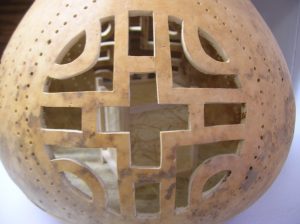
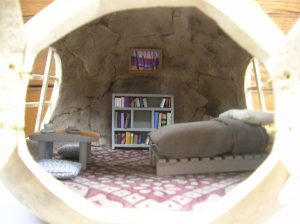
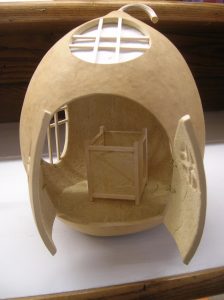
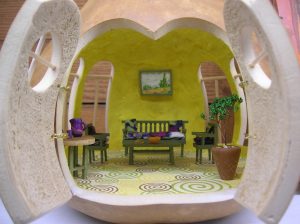
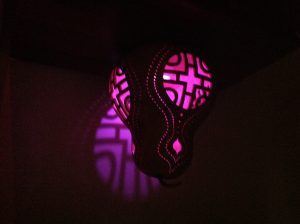
Two truths and a lie with Peggy-Gray
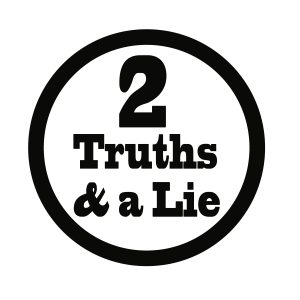 Clothing designer Peggy Gray, of 22 Shades of Gray, is up next in our Two Truths and a Lie contest. Which is the lie?!
Clothing designer Peggy Gray, of 22 Shades of Gray, is up next in our Two Truths and a Lie contest. Which is the lie?!
1. I exhibited my designs on a runway in NYC.
2. I worked for an international designer.
3. My designs were highlighted in an upscale home living magazine.
The lie was #1. Thanks for playing!
Valley Artisans Market is celebrating our 35th year in business with a contest: Two Truths and a Lie. Each week, from Sept. 18-Nov. 20, we will post two truths and a lie about one of our members on our FaceBook page. Guess the lie correctly by responding in the FaceBook post and you will be entered into a drawing to receive 35 percent off ONE item at VAM. (Yes, you can receive a discount off of an expensive painting, an item out of a Small Gallery show, or that piece you have had your eye on that is just out of reach.) The more correct guesses, the better your chances are of winning. The drawing will be held at VAM during our Holiday Open House on Nov. 26, 2016. To be a winner, you must sign up for our monthly email newsletter; find the link at the bottom of this page on our website. The winner will be notified via our newsletter. Winners must come into the market to make their purchase in person. Good luck!
Input your answer on our FaceBook page by Nov. 20 when the answer will be revealed.
Two truths and a lie with Debra-Ann Salat
 Embroiderer Debra-Ann Salat is up next in our Two Truths and a Lie contest. Which is the lie?!
Embroiderer Debra-Ann Salat is up next in our Two Truths and a Lie contest. Which is the lie?!
1. I fell out of a moving truck in the swamps of New Jersey.
2. I was a medical assistant who couldn’t stand the sight of blood.
3. When not embroidering, I am a master chef.
The lie was #3. Thanks for playing!
Valley Artisans Market is celebrating our 35th year in business with a contest: Two Truths and a Lie. Each week, from Sept. 18-Nov. 20, we will post two truths and a lie about one of our members on our FaceBook page. Guess the lie correctly by responding in the FaceBook post and you will be entered into a drawing to receive 35 percent off ONE item at VAM. (Yes, you can receive a discount off of an expensive painting, an item out of a Small Gallery show, or that piece you have had your eye on that is just out of reach.) The more correct guesses, the better your chances are of winning. The drawing will be held at VAM during our Holiday Open House on Nov. 26, 2016. To be a winner, you must sign up for our monthly email newsletter; find the link at the bottom of this page on our website. The winner will be notified via our newsletter. Winners must come into the market to make their purchase in person. Good luck!
Input your answer on our FaceBook page by Nov. 13 when the answer will be revealed and the next question will be posted.
Two truths and a lie with Barbara Sarvis
 Painter Barbara Sarvis is up next in our Two Truths and a Lie contest. Which is the lie?!
Painter Barbara Sarvis is up next in our Two Truths and a Lie contest. Which is the lie?!
1. I met Obama the night before his first election.
2. I have a brown belt in karate.
3. I attended Woodstock and didn’t stay for any of the performances.
The lie is #2. Thanks for playing!
Valley Artisans Market is celebrating our 35th year in business with a contest: Two Truths and a Lie. Each week, from Sept. 18-Nov. 20, we will post two truths and a lie about one of our members on our FaceBook page. Guess the lie correctly by responding in the FaceBook post and you will be entered into a drawing to receive 35 percent off ONE item at VAM. (Yes, you can receive a discount off of an expensive painting, an item out of a Small Gallery show, or that piece you have had your eye on that is just out of reach.) The more correct guesses, the better your chances are of winning. The drawing will be held at VAM during our Holiday Open House on Nov. 26, 2016. To be a winner, you must sign up for our monthly email newsletter; find the link at the bottom of this page on our website. The winner will be notified via our newsletter. Winners must come into the market to make their purchase in person. Good luck!
Input your answer on our FaceBook page by Nov. 6 when the answer will be revealed and the next question will be posted.
